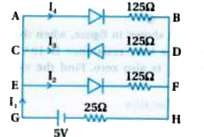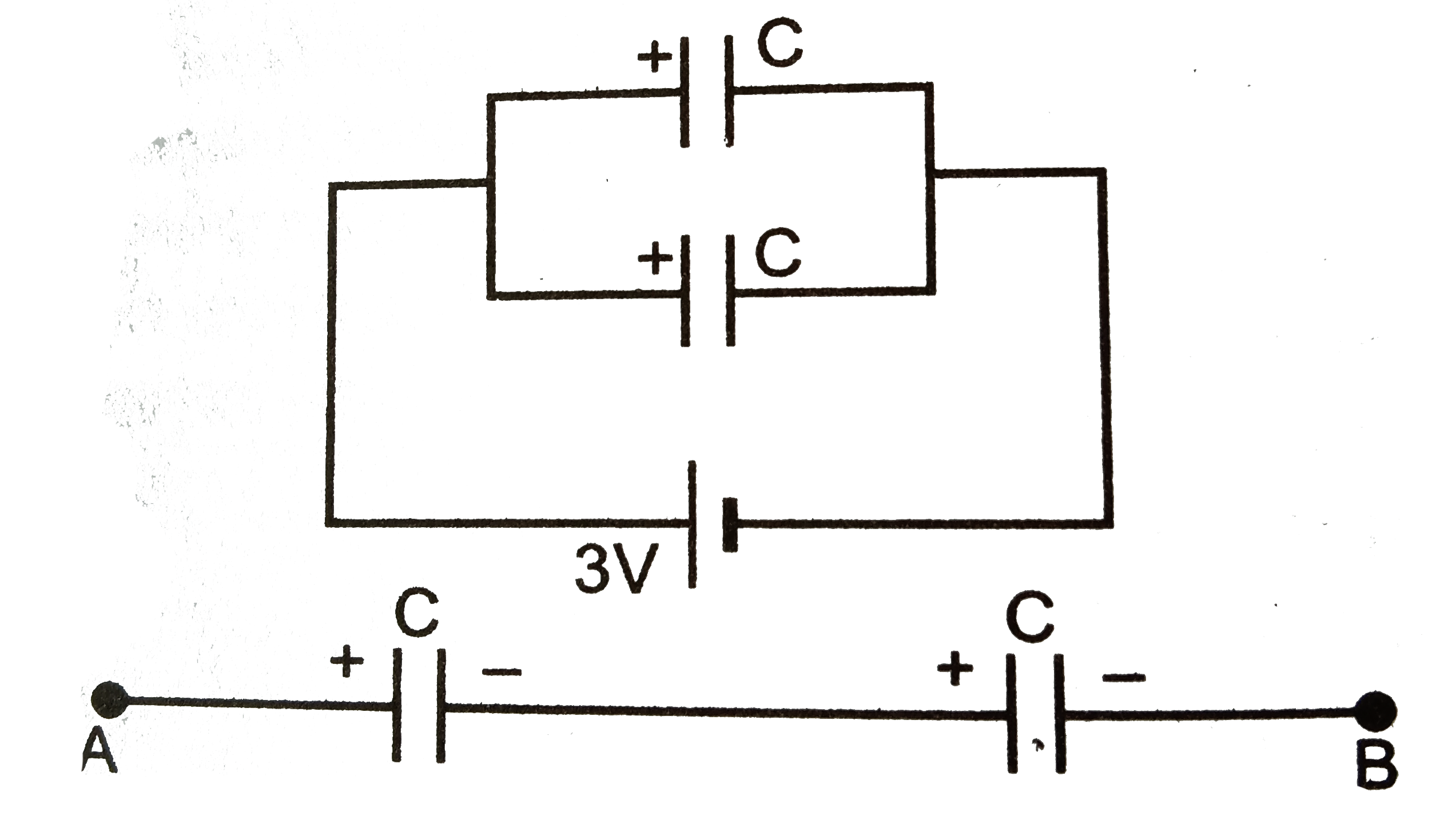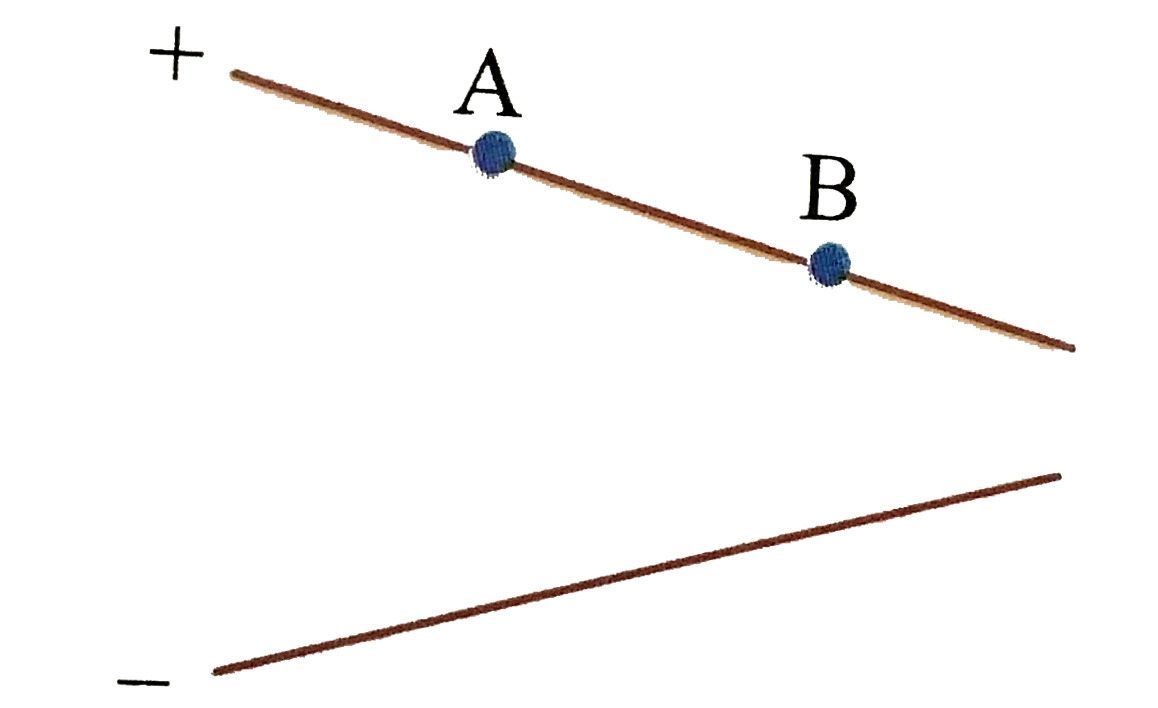3 identical capacitors are joined in parallel and are charged with a battery of 10 V. Now the battery is removed and they are joined in series with each other in this condition what would be the potential difference between the freed plates in the combination? Solution in Gujrati
For circuit (1) and (2)
For circuit (2) and (3)
For circuit (3) and (1)
None of the above circuits
The correct Answer is:A
Step by step video & image solution for 3 identical capacitors are joined in parallel and are charged with a battery of 10 V. Now the battery is removed and they are joined in series with each other in this condition what would be the potential difference between the freed plates in the combination? by Physics experts to help you in doubts & scoring excellent marks in Class 12 exams.
Topper's Solved these Questions
- BOOK - KUMAR PRAKASHANCHAPTER - SEMICONDUCTOR ELECTRONICS : MATERIALS, DEVICES AND SIMPLE CIRCUITS EXERCISE - Section-D : Multiple Choice Questions (MCQs) (MCQs asked in Competitive Exams)129videos
SEMICONDUCTOR ELECTRONICS : MATERIALS, DEVICES AND SIMPLE CIRCUITS
- BOOK - KUMAR PRAKASHANCHAPTER - SEMICONDUCTOR ELECTRONICS : MATERIALS, DEVICES AND SIMPLE CIRCUITS EXERCISE - Section-C: NCERT Exemplar Solution (Long Answer Type Questions)10videos
SEMICONDUCTOR ELECTRONICS : MATERIALS, DEVICES AND SIMPLE CIRCUITS
- BOOK - KUMAR PRAKASHANCHAPTER - SAMPLE QUESTION PAPER EXERCISE - PART-B SECTION-C5videos
SAMPLE QUESTION PAPER
- BOOK - KUMAR PRAKASHANCHAPTER - WAVE OPTICSEXERCISE - SECTION-D (MULTIPLCE CHOICE QUESTIONS (MCQS)) (MCQS FROM DARPAN BASED ON TEXTBOOK)239videos
WAVE OPTICS
Similar Questions
At absolute zero temperature Si acts as ……..
01:15View Solution
If each diode in figure has a forward bias resistance of 25Ω and infinite resistance in reverse bias, what will be the values of the current I1,I2,I3andI4?01:36View SolutionTwo charges –q and +q are located at points (0, 0, –a) and (0, 0, a), respectively.
(a) What is the electrostatic potential at the points (0, 0, z) and (x, y, 0) ?
(b) Obtain the dependence of potential on the distance r of a point from the origin when r/a>>1 .
(c) How much work is done in moving a small test charge from the point (5,0,0) to (–7,0,0) along the x-axis? Does the answer change if the path of the test charge between the same points is not along the x-axis?View SolutionAccording to particle theory of light what is the velocity of light in a dense medium, compared to that in rare medium ?
03:50View SolutionTen capacitors are joined in parallel and charged with a battery up to a potential V . Thery are then disconnected from the combination will be .
02:52View SolutionTwo identical parallel plate capacitors are connected in parallel to a3 volt battery. The battery is disconnected and the two capacitors are joined in series, Fig. What is the potentail difference between A and B ?
 04:15View Solution
04:15View SolutionThe plates of a parallel plate capacitor are charged by a battery and the battery is disconnected after the charging. Now, the plates are placed as shown in the figure. Then (plates are not parallel to each other).
 .04:15View Solution
.04:15View SolutionC तथा 2C धारिता के दो समान्तर प्लेट संधारित्र समांतर क्रम में V वोल्ट बैटरी से जोड़े जाते हैं। अब बैटरी हटा ली जाती हैं तथा संधारित्र C की प्लेटों के बीच k परावैघुतांक का पदार्थ भर दिया जाता हैं। संधारित्रों की प्लेटों के बीच विभवांतर ज्ञात कीजिये।
03:42View SolutionSix identical capacitors are joined in parallel, charged to a potential difference of 10 V, separated and then connected in series. Then the potential difference between the free plates is
05:15View Solutionसमान्तर प्लेट संधारित्र को एक बैटरी द्वारा आवेशित किया जाता है अब बैटरी हटाकर उसके प्लेटो के बिच परावैद्युत स्लैब डाला जाता है इन पर क्या प्रभाव पड़ेगा
विभान्तर04:03View SolutionA parallel plate capacitor of capacitances C is connected to a battery to charge it to a potential V. Similarly, another capacitor of capacitance 2C is charged to a potential 2V. Now the batteries are removed, and the two capacitors are connected in parallel by joining the positive plate to one with the negative plate of the other. Find out the final energy of the system.
04:11View SolutionSix identical capacitors, each of 1muF are joined in parallel and the combination is put across a battery of e.m.f. 2V. Now, the battery is disconnected and the capacitors are joined in series. The total energy are potential difference across the series combination is
04:29View Solutionएक समान्तर प्लेट संधारित्र की प्लेटों को बैटरी से जोड़कर आवेशित किया जाता है। अब यदि बैटरी हटाकर प्लेटों के बीच कुचालक माध्यम भरा जाए तो प्रत्येक दशा में क्या प्रभाव पड़ेगा : (i) प्लेटों के आवेश पर (ii) संधारित्र की धारिता पर, (iii) प्लेटों के बीच विद्युत् क्षेत्र पर, (iv) प्लेटों के बीच विभवान्तर पर, तथा (v) संधारित्र की ऊर्जा पर।
04:53View SolutionA battery is used to charge a parallel plate combination of two identical capacitors. If the potential difference across the battery is V and the total charge Q flows through the battery during the charging process then 1) The charge on each capacitor is Q/2 and the potential of each capacitor is V/2 2) The charge on each capacitor is Q and the potential of each capacitor is V 3) The charge on each capacitor is Q/2 and the potential of each capacitor is V 4) The charge on each capacitor is Q and the potential of each capacitor is V/2
02:50View SolutionSuppose n identical capacitors are joined in parallel and charged to potential V. Now, they are separated and joined in series. If the energy possessed by each capacitor is U, then on joining them in series, the energy and potential difference for the combination are
View Solutionएक समांतर - प्लेट संधारित्र , किसी निश्चित विभव तक आवेशित किया जाता है। फिर आवेशन करने वाली बैटरी अलग कर दी जाती है। अब यदि संधारित्र की प्लेटें एक दूसरे से परे की जाएँ , तो
View Solution

